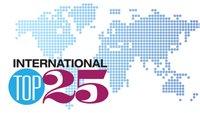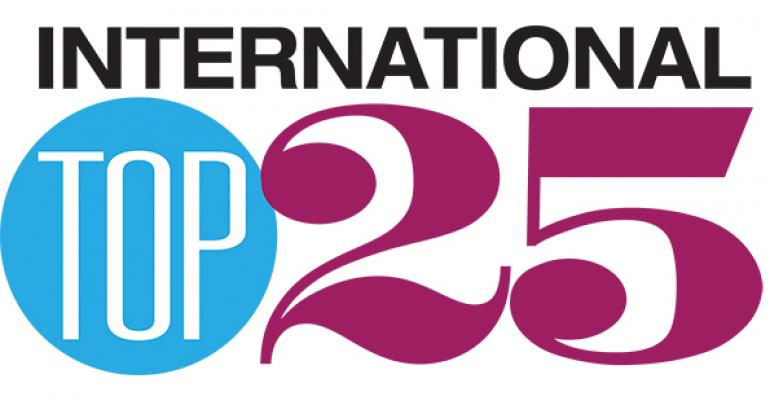The Top 25 foodservice chains based outside the United States and Canada outperformed their much larger American and Canadian competitors in 2013, stealing sales share from them as well, according to new research from market research firm Euromonitor International and Nation’s Restaurant News.
SPECIAL REPORT:
INTERNATIONAL TOP 25
Analysis:
• Meet the Top 25
• Top 5 growth chains
• Company analysis
• Western Europe
• Latin America
• Eastern Europe
• Asia-Pacific
• Middle East-Africa
• U.S.–Canada
Data:
• Chains by sales, growth
• Chains by worldwide units, growth
• Companies by sales, growth
• Chains by estimated sales per unit
Euromonitor, in ranking those 25 non-U.S.-Canada international chains on the basis of calendar 2013 worldwide systemwide sales, found that, in aggregate, their top line grew 7.5 percent to $55.4 billion, compared with growth of 7 percent a year earlier.
In comparison, the NRN-tracked Top 25 U.S. or Canada-based chains — ranked by reported or estimated worldwide systemwide sales for fiscal years ending from August 2013 to June 2014 — had 2.9-percent growth in latest-year global sales, to $267.8 billion. That growth rate represented a deceleration from the 5.3-percent expansion in the preceding year and the 8.9-percent increase two-years back.
To help provide insight and context for U.S. restaurant systems looking at international market trends, local-brand competition and economic factors, NRN teams with Euromonitor to exclusively present data and analysis for top international restaurant brands. This special report details systemwide sales and unit bases, as well as aggregate market data and projections into 2018, for international brands from around the world, including those based and operating in five key international regions: Asia-Pacific, Eastern Europe, Latin America, Middle East and Africa, and Western Europe.
The biggest international brands driving the group’s sales surge include Dicos, a Taiwan-based quick-service chain that specializes in Western-style food like fried chicken, burgers and fries; Costa Coffee, a U.K.-based coffee chain focused on high-quality, handmade coffee; and 7-Eleven, the global convenience-store powerhouse. Those three brands posted double-digit global sales gains in 2013, with Discos leading the pack with a 31.3-percent lift, Costa hitting an increase of 12.1 percent and 7-Eleven at 10.2 percent.
Both Dicos and Costa Coffee also posted double-digit gains in global unit counts — 27.4 percent and 11.2 percent, respectively. Joining the two brands in that top tier of unit growth was Saizeriya, a Japanese chain specializing in family-style Italian cuisine.
The latest-year sales performance by the U.S.-Canada Top 25 was hampered by significantly lower improvement in store-level output, as average growth in worldwide estimated sales per unit shrank to 0.7 percent from 3.1 percent a year earlier. That contrasted with a 1.8-percent average rate of growth in 2013 ESPUs among international Top 25 chains.
On a worldwide basis, the U.S.-Canada Top 25 saw their latest-year aggregate unit base increase by 4.6 percent, to 218,963 locations, compared with a preceding-year rise of 4.2 percent, to 209,368. International Top 25 chains increased their aggregate worldwide 2013 unit total by 4.9 percent, to 116,107, representing a significant gain from 2012’s growth of 2.4 percent, to 110,740 establishments.

Methodology
The International Top 25 is a look at the 25 largest restaurant chains and parent companies with headquarters outside of the United States and Canada based on their worldwide foodservice sales, as calculated by London-based Euromonitor International.
The International Top 25 companies selected by Euromonitor qualified on the basis of worldwide systemwide sales, or the receipts from company-operated and franchised or licensed restaurants for all of the proprietary concepts owned by the company in question. However, Euromonitor excludes from its company “sales” presentations the sales, if any, from concepts licensed or franchised from others.
The “25” in the International Top 25 refers both to the rosters of the largest international players and to the five leading chains and parent companies in five regions selected by the research house and NRN: Asia-Pacific, Eastern Europe, Latin America, Middle East-Africa and Western Europe. The chains were selected based on their headquarters’ regions and their sales within their home regions, while the companies — based in the same regions — made the small roster on the basis of the aggregate systemwide sales within their home regions from all their proprietary concepts.
For its part in the research, NRN compiled a list of the Top 5 retail foodservice chains, as opposed to contract operations and hotels, with headquarters in the United States or Canada based on international sales, or those generated by their systems outside of their home countries. For the purposes of International Top 25, NRN followed Euromonitor’s lead and reported for companies the systemwide international sales of all their proprietary brands.
It should be noted that while NRN sees the International Top 25 as a natural extension of its Top 200 series on domestic foodservice activity, the presentation of data for the International Top 25 differs greatly from that used for Top 100 and Second 100. Even apart from Euromonitor’s use of aggregate concept systemwide sales for companies, as opposed to Top 200’s revenue from company-restaurant sales, franchise fees and franchise sales royalties, the presentations for this report differ in other ways from NRN’s Top 200 practices.
Among the differences: Euromonitor presents all numbers based on calendar-year results versus the actual fiscal years of the spotlighted chains or parents; includes in sales numbers the full amount paid by consumers to the chains, including value added taxes where applicable; and converts all sales numbers in a multiyear series to U.S. dollars based on a fixed rate for the latest year in question, which for the International Top 25 means 2013.
The global economy is uneven and restaurant development will have to be targeted. Looking forward, some economic projections for international growth have been lowered.
“Over the last three years we have revised our estimates of potential growth down — a bit for advanced economies, [where] it was already quite low, and much more so, in terms of magnitudes, for emerging market economies,” Olivier Blanchard, International Monetary Fund economic counselor, said in October after the IMF revised downward half or more of the national or regional economic output forecasts. “We’re not going to return to anything like the growth rates of the first half of the 2000s.”
“Emerging market growth is still high — not as high as it used to be,” Blanchard said.
Apart from the pure economic opportunities and challenges that are part of building restaurants overseas, consumer and political developments in other countries continue to test areas of the balance sheets for some of the world’s largest companies. Most notable among them, KFC and Pizza Hut-parent Yum! Brands Inc. and McDonald’s Corp., both of which have seen negative public perception and sinking same-store sales spring from a poultry supplier scandal in China in July. And then there is the Big Mac’s recent singling out for health inspections and unit closures in Russia as a result of political tensions between the U.S. and Russia.
“While we’ve done everything we can to turn the situation around, what we need most right now is the gift of time,” said David C. Novak, Yum Brands chairman, when speaking to analysts in August.
Yum reported a 13-percent decrease in same-store sales for the entire $8.2-billion China market for fiscal 2013, and a 15-percent hit for its KFC stores there, in the aftermath of the highly publicized government investigation of one of the company’s Chinese suppliers and media coverage of an avian flu outbreak in that country.
Approximately 81.7 percent of KFC’s $23 billion in sales came from international markets, while McDonald’s international business accounted for 59.8 percent of its $89.1 billion in global sales. Pizza Hut’s international locations rang up 52.5 percent of their $12 billion in worldwide system sales.
Correction: Dec. 18, 2014 This article has been revised to reflect corrected aggregate unit totals and year-over-year percent changes in those totals for International Top 25 chains.





